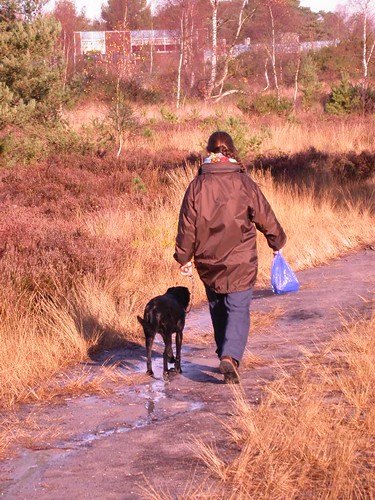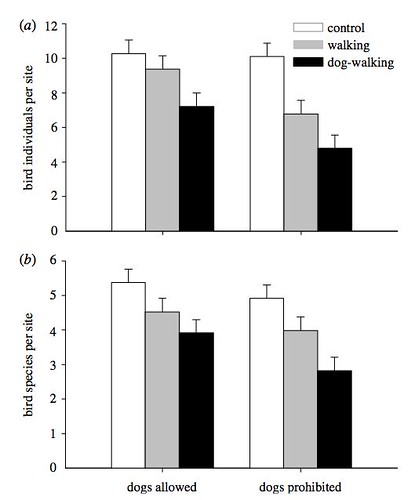tags: researchblogging.org, dog walking, wild birds, ground-nesting birds, conservation, peer-reviewed research
Millions of people walk their dogs every day, and many of them enjoy walking their dogs in natural areas where birds and other wild animals live. Unfortunately, a scientific paper was recently published showing that the presence of dogs, even when they are on a leash in these natural areas, seriously interferes with wild birds' reproductive success and even scares many of them away.
This research, carried out by Peter Banks and his student, Jessica Bryant, at the University of New South Wales in Australia, compared bird numbers between 45 parks where dogs are legally walked to 45 parks where dog walking is illegal. The dogs that participated in the study were all on a leash, were of a variety of ages and sizes, and included both purebreds and mutts, while the walkers were also of a variety of heights. They also had people, unaccompanied by dogs, walk through these same areas, to distinguish how much disturbance was caused by people walking alone.
Beginning 20 seconds after the dog and its walker (or the unaccompanied walker) had passed through a particular area, the scientists censused all birds that were within 50 meters. They found that dog walking caused nearly half of all individual wild birds to temporarily abandon the area, while more than one-third of all bird species permanently abandoned these areas (Figure1);
Figure 1. Dog walking in natural areas reduces (a) bird abundance and (b) bird diversity. Ninety sites were treated with either walkers with dogs on leads (black bars), walkers alone (grey bars) or no treatment (white bars). Half the sites were in areas where dog walking was permitted and the other where dogs were prohibited. Values represent least-squared means +/-s.e. from an ANCOVA which included significant wind effects.
"We found in field studies that dog-walking in bushland causes a 35 percent reduction in bird diversity -- the number of species -- and a 41 percent reduction in abundance -- the number of individual birds in an area," observed Banks.
Not surprisingly, the researchers found that ground-nesting birds were most affected by dog-walking since these birds were usually absent altogether from areas where dogs were walked. They also found that habituation t othe presence of dogs played no role in decreasing the birds' flight.
"The effect occurs even in areas where dog-walking is common and where they are prohibited, indicating that birds don't become accustomed to continued disturbance by dogs. This evidence clearly supports the long-term prohibition of dog-walking from sensitive conservation areas," Banks reports.
In short, walking dogs through natural areas, even if those dogs are on a leash (and it has been my experience that a significant number of them are not on a leash), has a significant and powerful negative effect upon the abundance and diversity of bird species that are present in these areas.
"If dogs walk throughout an area, you're just not going to get the same bird-watching experience," concluded Banks.
NOTE: I am interested to read your thoughts about this study. Specifically, I am interested to know if the data that the authors presented in their paper were convincing? If not, what other data should they collect to add strength to their argument?
Source:
Banks, P.B., Bryant, J.V. (2007). Four-legged friend or foe? Dog walking displaces native birds from natural areas. Biology Letters, 3(6), 611-613. DOI: 10.1098/rsbl.2007.0374



I'm not sure based on those graphs, but it looks like humans walking cause almost as much damage as dogs walking.
Those graphs don't seem to support those conclusions.
They seem to show the same absolute numbers of species in areas that saw dog walking and didn't. They seem to show a greater reduction in individual birds and individual species where the birds were less used to the dogs (or the mix of species changed close to the paths).
Add to that the fact that a 50 metre census means that the very important influence the topology of the parks and paths would have on the outcome has not been accounted for. (If all paths are within 50 metres of each other the meaning of these results is different than if they are, on average, 300metres apart.
What's really interesting though is that in the dogs-prohibited area the negative effect of humans on their own was much greater. This indicates that dog walking areas might well see more people in general - so in fact the sensible conclusion might be to allow dog-walking in the other to spread the harm out more evenly - or ban people altogether to eliminate it.
It is an interesting study, but I believe it might not be wise to apply it across the board, especially since personal observation seems to hint otherwise.
Here in Singapore, feral packs of pariah dogs are present in many nature areas. Some of these packs live in areas with great diversity and high populations of birds of all sorts. And so far, it seems that while the birds will fly away to avoid an approaching dog, they don't seem too perturbed by the presence of the dogs.
In fact, I think as far as my country is concerned, people are still the primary source of disturbance, what with yelling and screaming people, or folks who can't stop blasting music from their cellphones while walking through these areas.
If there weren't people and dogs in these "natural" areas, guess what would be there instead? Foxes, coyotes, wildcats, etc. If you're a bird, I think you'd much rather face a well-fed weiner dog than a hungry fox. I'll bet that by keeping serious predators away, people and dogs actually increase the number of birds in these areas.
I know in our little corner of the wild, that our dogs keep foxes and coyotes OUT of the area. They don't usually eat many birds (only dying ones as the healthy can fly away). Our dogs are kept on paths where ground nesters live and can run around where they don't. We've had significant increases in bird numbers since we moved her mainly because we changed the land use from farming to wilderness. We walk it to make sure it is safe for us, the dogs, and the animals. Maybe it is the decrease in wild spaces (more humans and dogs) that is the main factor in bird population losses.
For the record, our dogs do not eat birds. The foxes and coyotes do. The majority of birds eaten here are taken by other bigger birds. Cats are live trapped and taken to the humane society.
The graphs look like the areas that allow dog walking historicly have higher bird numbers and diversity. Dog walking in those areas appears to result in the same species diversity and numbers as people-walking does in the dogs-prohibited areas. As such, the control areas may not be meaningful controls. As to more data, what is most important is measures of reproductive success. How many nests were in each area, what was the nest success, etc. They also measured birds observed. If a bird remained hidden, skulked, or otherwise was not observed it wasn't counted. There needs to be some sort of absolute comparison among all the sites for species present, numbers.
Further, what is the quality of thge habitat? Was it "prime" or "marginal". Species behavior may be different depending on habitat quality.
To account for bias, commenters must divulge whether or not they are dog owners ;)
I came across this from Tweeters, and then your blog. It is an interesting set of data. I know that every dog must have it's day, but I guess my preference is to see dogs not allowed in most natural areas. While most dogs are well-controlled by their owners, I always seem to "luck out" and find exceptions. I think having set-aside areas for dogs is great. Our little town has an Animal Acres Park, where dogs can run free.
(Having dogs in a dog-prohibited area seems the worst, my experience is now not to say anything to the owner - who after all is responsible.)
I generally do all my birding with my pet pug by my side.He is allways leashed and does not make alot of noise.In the times he has been with me I have allways had great spotting moments and the birds have obliged.As for ground nesting birds I for one have not seen a bird nesting on a buisy or even a seldom used trail.
First of all, it's Australia--there's a much more extended breeding season there, and probably a lot more birds that nest low to the ground (or ON the ground) than in most areas that see a lot of dog walkers in Europe or North America.
Secondly of all, it's not clear that banning people with dogs, but not people without dogs would make much difference.
Birds definitely know the difference between people who are not aware of them, and people who are paying close attention to them--any birder knows this. And this, sadly, means that birding itself can be a source of stress for birds. In the breeding season, we all have to take special care not to disrupt their activities.
While wild predators may be a worse risk to birds than domesticated predators like dogs (though feral cats are invariably the worst), in an area with a high human population density, there would also be a much higher number of dogs than there would be of natural predators--and of course, the natural predators would be mainly nocturnal, and the birds would end up having to deal with both.
I think it has to be a case-by-case thing. Some areas have to be off-limits to both dog walkers, and most humans without dogs, at least during the most sensitive breeding periods.
However, to ban dogs from all remotely natural areas, on all continents--not practical, or desirable. And in some instances, the presence of dogs may deter feral cats, at least temporarily. If feral cats are present, that's a far worse risk to birds, on any continent, and they are definitely a problem in Australia.
If you're trying to deal with angry dog walkers who feel excluded from local trails, as well as angry feral cat defenders, trying to maintain 'TNR' colonies, you are simply foredoomed to failure.
And yeah, I have a dog. But I like cats. Indoors. ;)
I don't see any data about how long the birds stayed away - if they leave for five minutes and then return, I am skeptical of the significance of the effect.
Also, how useful would the conlusions be anywhere else in the world? The birds in question evolved on a continent with only one (semi-)native specices of canine. Even if the effect is significant, does it mean anything in Africa, Eurasia, or the Americas?